ZEN IRODALOM ZEN LITERATURE
« Zen index
« Home
十牛圖 Shiniu tu [Jūgyūzu]
The Ten Oxherding Pictures
Introduction and verse by 廓庵師遠 Kuoan Shiyuan [Kakuan Shien], 12th century,
translated by Philip Kapleau (1912-2004)
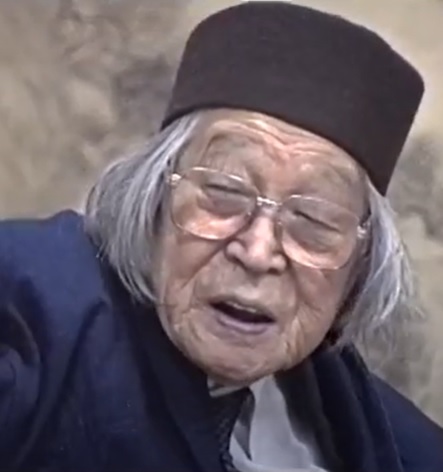
Paintings by 直原玉青 Jikihara Gyokusei (1904-2005)
[Chapter] VIII.
in: Philip Kapleau: The Three Pillars
of Zen: Teaching, Practice, and Enlightenment, Tokyo: John Weatherhill,
1965; New York: Harper and Row, 1966. pp. 301-313.
Sources:
http://www.imeditate.com/books_music/oxherding/ox01.html
http://www.jmeditate.com/enlightenment/oxherding/ox01.html
http://www.4peaks.com/ppox.htm
直原玉青
Jikihara Gyokusei
(1904-2005), a
Japanese master of calligraphy and a teacher in the Obaku School of Zen. The
Ten Oxherding pictures presented are reproductions of ink paintings by Jikihara
Sensei in 1982, during one of his many visits to Zen Mountain Monastery, and
presented as a gift. They are a beautiful example of traditional Chinese-style
nanga brush painting. The originals are on display at Zen Mountain
Monastery.
http://mro.org/zmm/training/zenarts/oxherdinggallery.php
[This series differs from from the ink-and-brush paintings published by Jikihara Gyokusei in The Three Pillars of Zen, in 1965.]
[Introduction]
Among the
various formulations of the levels of realization in Zen, none is more widely
known than the Oxherding Pictures, a sequence of ten illustrations annotated
with comments in prose and verse. It is probably because of the sacred nature
of the ox in ancient India that this animal came to be used to symbolize man's
primal nature or Buddha-mind.
The original drawings and the commentary that accompanies them are both attributed
to Kakuan Shien (Kuo-an Shih-yuan), a Chinese Zen master of the twelfth century,
but he was not the first to illustrate the developing stages of Zen realization
through pictures. Earlier versions of five and eight pictures exist in which
the ox becomes progressively whiter, the last painting being a circle. This
implied, that the realization of Oneness (i.e., the effacement of every conception
of self and other) was the ultimate goal of Zen. But Kakuan, feeling this
to be incomplete, added two more pictures beyond the circle to make it clear
that the Zen man of the highest spiritual development lives in the mundane
world of form and diversity and mingles with the utmost freedom among ordinary
men, whom he inspires with his compassion and radiance to walk in the Way
of the Buddha. It is this version that has gained the widest acceptance in
Japan, has proved itself over the years to be a source of instruction and
unfailing inspiration to Zen students, and is presented here [in new English
translation].
1. Seeking the Ox
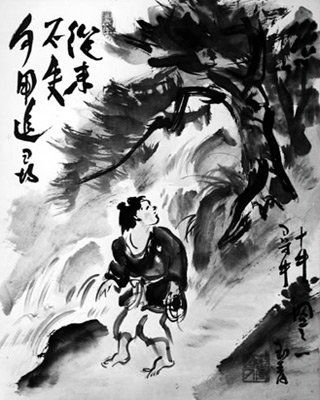
The Ox has
never really gone astray, so why search for it? Having turned his back on
his True-nature, the man cannot see it. Because of his defilements he has
lost sight of the Ox. Suddenly he finds himself confronted by a maze of crisscrossing
roads. Greed for worldly gain and dread of loss spring up like searing flames,
ideas of right and wrong dart out like daggers.
Desolate through
forests and fearful in jungles,
he is seeking an Ox which he does not find.
Up and down dark, nameless, wide-flowing rivers,
in deep mountain thickets he treads many bypaths.
Bone-tired, heart-weary, he carries on his search
for this something which he yet cannot find.
At evening he hears cicadas chirping in the trees.
2. Finding the Tracks
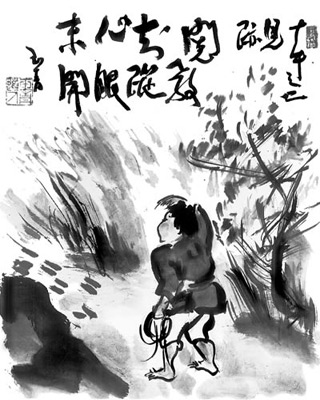
Through the
sutras and teachings he discerns the tracks of the Ox. [He has been informed
that just as] different-shaped [golden] vessels are all basically of the same
gold, so each and every thing is a manifestation of the Self. But he is unable
to distinguish good from evil, truth and falsity. He has not actually entered
the gate, but he sees in a tentative way the tracks of the Ox.
Innumerable
footprints has he seen
in the forest and along the water's edge.
Over yonder does he see the trampled grass?
Even the deepest gorges of the topmost mountains
can't hide this Ox's nose which reaches right to heaven.
3. First Glimpse of the Ox
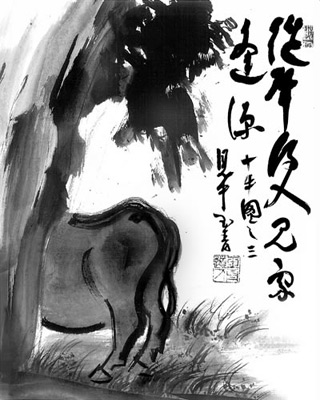
If he will
but listen intently to everyday sounds, he will come to realization and at
that instant see the very Source. These six senses are no different from this
true Source. In every activity the Source is manifestly present. It is analogous
to the salt in water or the binder in paint. When the inner vision is properly
focused, once comes to realize that that which is seen is identical with the
true Source.
A nightingale
warbles on a twig,
the sun shines on undulating willows.
There stands the Ox, where could it hide?
That splendid head, those stately horns,
what artist could portray them?
4. Catching the Ox
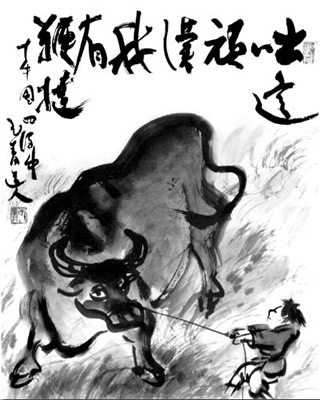
Today he encountered
the Ox, which had long been cavorting in the wild fields, and actually grasped
it. For so long a time has it reveled in these surroundings that breaking
it of its old habits is not easy. It continues to yearn for sweet-scented
grasses, it is still stubborn and unbridled. If he would tame it completely,
the man must use his whip.
He must tightly
grasp the rope and not let it go,
for the Ox still has unhealthy tendencies.
Now it charges up to the highlands,
now it loiters in a misty ravine.
5. Taming the Ox
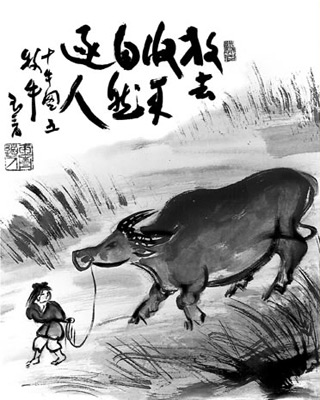
With the rising
of one thought another and another are born. Enlightenment brings the realization
that such thoughts are not unreal since even they arise from our True-nature.
It is only because delusion still remains that they are imagined to be unreal.
This state of delusion does not originate in the objective world but in our
own minds.
He must hold
the nose-rope tight and not allow the Ox to roam,
lest off to muddy haunts it should stray.
Properly tended, it becomes clean and gentle.
Untethered, it willingly follows its master.
6. Riding the Ox Home
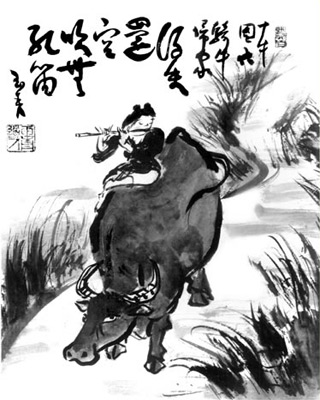
The struggle
is over, "gain" and "loss" no longer affect him. He hums
the rustic tune of the woodsman and plays the simple songs of the village
children. Astride the Ox's back, he gazes serenely at the clouds above. His
head does not turn [in the direction of temptations]. Try though one may to
upset him, he remains undisturbed.
Riding free
as air he buoyantly comes home
through evening mists in wide straw-hat and cape.
Wherever he may go he creates a fresh breeze,
while in his heart profound tranquility prevails.
This Ox requires not a blade of grass.
7. Ox Forgotten, Self Alone
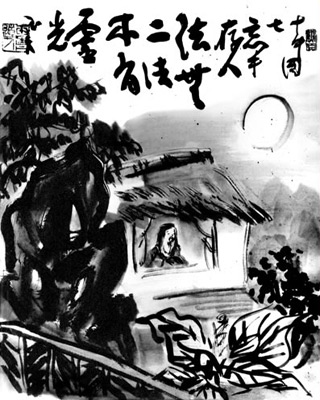
In the Dharma
there is no two-ness. The Ox is his Primal-nature: this he has now recognized.
A trap is no longer needed when a rabbit has been caught; a net becomes useless
when a fish has been snared. Like gold which has been separated from dross,
like the moon which has broken through the clouds, one ray of luminous Light
shines eternally.
Only on the
Ox was he able to come Home,
But lo, the Ox is now vanished, and alone and serene
sits the man.
The red sun rides high in the sky
as he dreams on placidly.
Yonder beneath the thatched roof
his idle whip and idle rope are lying.
8. Both Ox and Self Forgotten
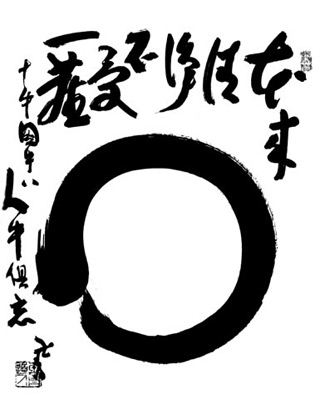
All delusive
feelings have perished and ideas of holiness too have vanished. He lingers
not in [the state of "I am a] Buddha," and he passes quickly on
through [the stage of "And now I have purged myself of the proud feeling
'I am] not Buddha.'" Even the thousand eyes [of five hundred Buddhas
and Dharma masters] can discern in him no specific quality. If hundreds of
birds were now to strew flowers about his room, he could not but feel ashamed
of himself.
Whip, rope,
Ox and man alike belong to Emptiness.
So vast and infinite the azure sky
that no concept of any sort can reach it,
Over a blazing fire a snowflake cannot survive.
When this state of mind is realized
comes at last comprehension
of the spirit of the ancient Patriarchs.
9. Returning to the Source
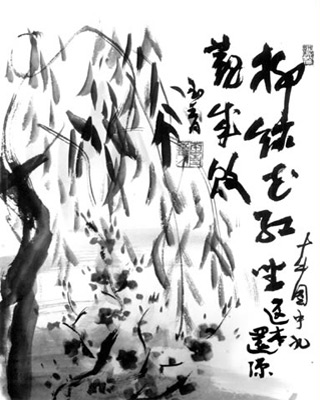
From the very
beginning there has not been so much as a speck of dust [to mar the intrinsic
Purity]. He observes the waxing and waning of life in the world while abiding
unassertively in a state of unshakable serenity. This [waxing and waning]
is no phantom or illusion [but a manifestation of the Source]. Why then is
there need to strive for anything? The waters are blue, the mountains are
green. Alone with himself, he observes things endlessly changing.
He has returned
to the Origin, come back to the Source,
but his steps have been taken in vain.
It is as though he were now blind and deaf.
Seated in his hut, he hankers not for things outside.
Streams meander on of themselves,
red flowers naturally bloom red.
10. Entering the Marketplace with Helping Hands
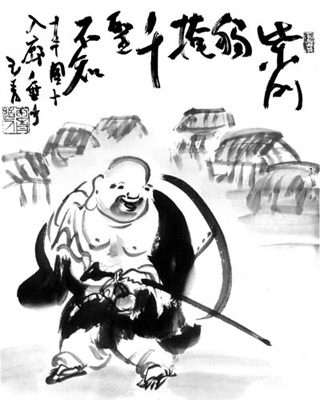
The gate of
his cottage is closed and even the wisest cannot find him. His mental panorama
has finally disappeared. He goes his own way, making no attempt to follow
the steps of earlier sages. Carrying a gourd, he strolls into the market;
leaning on his staff, he returns home. He leads innkeepers and fishmongers
in the Way of the Buddha.
Barechested,
barefooted, he comes into the marketplace.
Muddied and dust-covered, how broadly he grins!
Without recourse to mystic powers,
withered trees he swiftly brings to bloom.